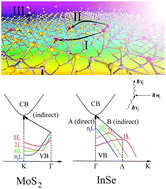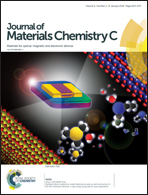Atomic-scale mechanisms of defect- and light-induced oxidation and degradation of InSe†
Abstract
Layered indium selenide (InSe), a new two-dimensional (2D) material with a hexagonal structure and semiconducting characteristics, is gaining increasing attention owing to its intriguing electronic properties. Here, by using first-principles calculations, we reveal that perfect InSe possesses high chemical stability against oxidation, superior to MoS2. However, the presence of intrinsic Se vacancy (VSe) and light illumination can markedly affect its surface activity. In particular, the excess electrons associated with the exposed In atoms at the VSe site under illumination are able to remarkably reduce the dissociation barrier of O2 to ∼0.2 eV. Moreover, under ambient conditions, the splitting of O2 enables the formation of substitutional (apical) oxygen atomic species, which further cause the trapping and subsequent rapid splitting of H2O molecules and ultimately the formation of hydroxyl groups. Our findings uncover the causes and underlying mechanisms of InSe surface degradation via defect-photo-promoted oxidations. Such results will be beneficial in developing strategies for the storage of the InSe material and its applications for surface passivation with boron nitride, graphene or In-based oxide layers.



 Please wait while we load your content...
Please wait while we load your content...